TEPCO practices risk management to prevent accidents or disasters.
The Risk Management Committee, chaired by the president of TEPCO as the chief risk management executive, plays a central role in assessing and evaluating risks that could have a particularly serious impact on business. Its deliberations are reflected in annual management plans.
Risks specific to each risk management unit (head office departments, offices, and Group companies) are managed and addressed by each risk manager. Risks common to all risk management units are addressed by internal committees.
TEPCO has also established an emergency framework, though consistent efforts are made to collect the necessary information for preventing the occurrence of risks, providing a stable supply of electricity, and delivering high quality services.
Risk management framework
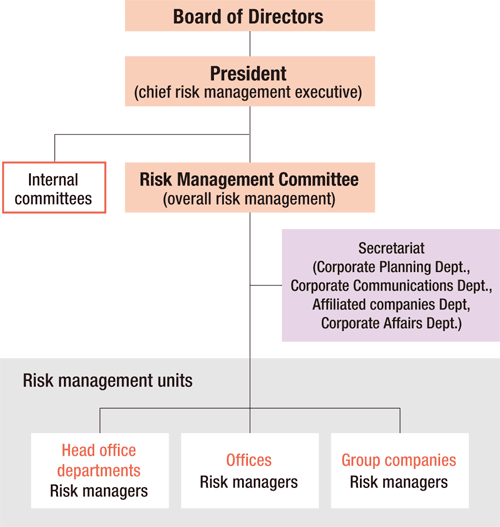
TEPCO is constantly strengthening its response to emergencies and disasters by creating disaster response plans and internal manuals, and establishing a company-wide risk management system.
TEPCO has established a basic disaster prevention plan in place, which includes disaster response plans and internal manuals, to prevent power facility damage in the event of an emergency or disaster, and to mitigate the scale of damage or achieve quick recovery should a disaster occur.
Basic policy on accident prevention measures
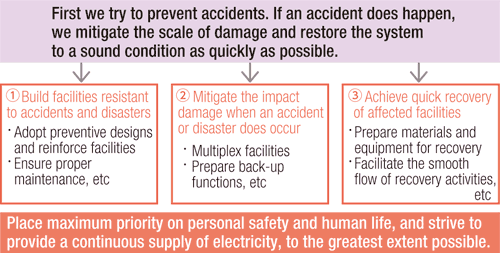
When faced with an accident/disaster or even the threat of one, TEPCO immediately issues an emergency alert. We set up emergency response centers at the Head Office and branch offices, and promptly enter system recovery mode.
We have materials and equipment necessary for recovery work stored in local depots throughout our service area and a cooperative framework with electric power companies in other regions to ensure timely recovery.
Emergency alerts
| Emergency alert category | Status of accident or disaster |
|---|---|
Class 1 emergency
|
An accident or disaster is predicted. An accident or disaster has occurred. |
Class 2 emergency
|
A large-scale accident or disaster is predicted. A large-scale accident or disaster has occurred A wide-area power outage has suddenly occurred due to an electrical accident An earthquake alert has been issued in the Tokai region |
Class 3 emergency
|
A large-scale accident or disaster has occurred, and recovery is expected to take a long time An earthquake greater than intensity 6-lower has occurred in TEPCO's service area or a prefecture where a TEPCO office is located An earthquake warning has been issued in the Tokai region |
In Japan, there is great concern about the impending possibility of a strong earthquake in Tokyo or the Tokai region. Even in the face of disaster, however, electric power companies have a social responsibility to deliver a stable supply of electricity, and are therefore expected to be able to take a comprehensive approach against unexpected accidents or disasters. For its part, TEPCO routinely implements information liaison training, accident recovery training, and initial response training, as well as participates in national and local emergency drills.
In addition to the Great Hanshin-Awaji Earthquake, a number of accidents and disasters have impacted power supply in Japan in the past. For example, a crane ship's collision with a power transmission line in 2006 caused a large-scale power outage, and the Niigata-Chuetsu-Oki Earthquake of 2007 brought damage to a power station. We have compiled an in-house manual on countermeasures derived from these incidents, and take the occasion of emergency drills to verify the effectiveness of those countermeasures and further improve our responses. We also regard emergency drills as an opportunity to identify potential issues, and implement various training programs in order to dig out as many issues as possible.
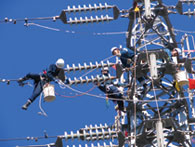 Accident recovery training atop a transmission line tower
Accident recovery training atop a transmission line tower
(*) Company-wide information liaison training
An information liaison training involving all TEPCO offices and related companies is implemented every year, to coincide with the "disaster prevention and volunteer activity week" in January. It is held without prior notice, to simulate as real a situation as possible, and aims to enhance disaster response capacities through hands-on experience in gathering information and executing disaster response activities.
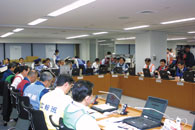 Company-wide information liaison training(*)
Company-wide information liaison training(*)
TEPCO has formulated an action plan outlining the basic concepts for H1N1 influenza response, and are working to concretize and elaborate control measures under the basic policy, "aim to provide stable power supply even during an influenza outbreak and fulfill our social responsibility to maintain the lifeline function while placing top priority on employee safety and health."
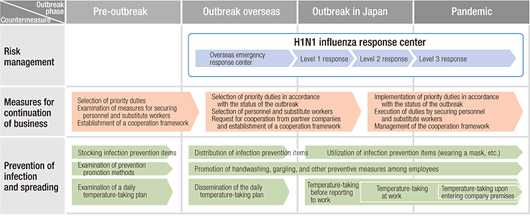
© Tokyo Electric Power Company Holdings, Inc.